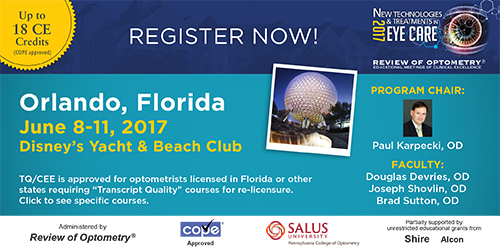
A
weekly e-journal by Art Epstein, OD, FAAO
Off the Cuff: 1-800 Contacts’ True Colors
A year ago, Arizona optometry, led by our remarkable Legislative Chair, Annette Hanian, was wrapping up one of the most contentious legislative sessions in optometry’s history. Fueled by big-profit-above-all-else VC dollars, supported by hordes of lobbyists and promoted by PR flacks, 1-800 waged war on common-sense, patient-protective contact lens regulations as well as primary eye care providers.
|
|||||
 |
||
| Preservative Benzalkonium Chloride Potently Induces Mitochondrial Dysfunction and Preferentially Affects LHON Mutant Cells | ||||
Researchers wrote that benzalkonium chloride (BAK) is the most commonly used eye drop preservative. However, they added, BAK has been associated with toxic effects such as dry eye and trabecular meshwork degeneration, but the underlying biochemical mechanism of ocular toxicity by BAK is unclear. In their study, they suggested a mechanistic basis for BAK's adverse effects. Mitochondrial O2 consumption rates of human corneal epithelial primary cells (HCEP), osteosarcoma cybrid cells carrying healthy (control) or Leber’s hereditary optic neuropathy (LHON) mutant mtDNA [11778(G>A)], were measured before and after acute treatment with BAK. Mitochondrial adenosine triphosphate (ATP) synthesis and cell viability were also measured in the BAK-treated control including LHON mutant and human-derived trabecular meshwork cells (HTM3). Benzalkonium chloride inhibited mitochondrial ATP (IC50, 5.3μm) and O2 consumption (IC50, 10.9μm) in a concentration-dependent manner, by directly targeting mitochondrial complex I. At its pharmaceutical concentrations (107μm to 667μm), BAK inhibited mitochondrial function >90%. In addition, BAK elicited concentration-dependent cytotoxicity to cybrid cells (IC50, 22.8μm) and induced apoptosis in HTM3 cells at similar concentrations. Furthermore, researchers showed that BAK directly inhibited mitochondrial O2 consumption in HCEP cells (IC50, 3.8 μM) at 50-fold lower concentrations than used in eye drops and that cells bearing mitochondrial blindness (LHON) mutations were further sensitized to BAK's mitotoxic effect. In this study, BAK inhibited mitochondria of human corneal epithelial cells and cells bearing LHON mutations at pharmacologically relevant concentrations. Researchers suggested that this is the basis of BAK's ocular toxicity. They added that prescribing BAK-containing eye drops should be avoided in patients with mitochondrial deficiency, including LHON patients, LHON carriers and possibly primary open-angle glaucoma patients. |
||||
SOURCE: Datta S, Baudouin C, Brignole-Baudouin F, et al. the eye drop preservative benzalkonium chloride potently induces mitochondrial dysfunction and preferentially affects LHON mutant cells. Invest Ophthalmol Vis Sci. 2017;58(4):2406-12. |
||||

|
||
|
|||
| Meibomian Gland and Tear Film Changes in Patients with Pterygium | ||||
Recent studies have demonstrated that pterygium has a close relationship with dry eye disease. This study aimed to determine abnormalities in meibomian gland and tear function in patients with pterygium, and to assess the relationship between the variables. Forty eyes from 40 patients with primary nasal pterygium, and 40 eyes from 40 volunteers without ocular pathologies were enrolled. Ocular surface disease index scores, meibomian gland expression scores, lid margin abnormality scores, meiboscore, tear film breakup time (BUT), Schirmer test (SIT) value, lower tear meniscus height (TMH), tear meniscus depth (TMD) and tear meniscus area (TMA) using Fourier domain optical coherence were performed. Ocular symptom scores, BUT scores, lid margin abnormality, meibomian gland expression and meiboscore were significantly higher in pterygium patients than in controls. However, SIT scores, lower TMH, TMD and TMA values did not reveal a significant difference between two groups. Multivariate regression analysis demonstrated that meiboscore significantly correlated with ocular symptom scores, BUT, lid margin abnormality scores and meibomian gland expression scores. Investigators wrote that meibomian gland function may be altered in pterygium patients, a condition that is associated with uncomfortable ocular symptoms. They encouraged the need for clinician awareness of meibomian gland changes to understand the complex relationship between pterygium, tear film functions and ocular surface changes. |
||||
SOURCE: Ye F, Zhou F, Xia Y, et al. Evaluation of meibomian gland and tear film changes in patients with pterygium. Indian J Ophthalmol. 2017;65(3):233-237. |
||||
 |
||
| Natural History and Predictors of Progression to Sjögren's Syndrome Among Participants of the SICCA registry | ||||
This study explored changes in the phenotypic features of Sjögren's syndrome (SS) and in SS status among participants in the Sjögren's International Collaborative Clinical Alliance (SICCA) registry over a two- to three-year interval. All participants in the SICCA registry who were found to have any objective measures of salivary hypofunction, dry eye, focal lymphocytic sialadenitis in minor salivary gland biopsy or anti-SSA/B antibodies were recalled over a window of two to three years after their baseline examinations to repeat clinical examinations and specimen collections. This goal was to determine whether there was any change in phenotypic features and in SS status. As of September 15, 2013, 3,514 participants had enrolled in SICCA, and of the eligible 3,310, 771 presented for a follow-up visit. Among individuals found to have SS using the 2012 ACR classification criteria, 93% again met the criteria after two to three years, and this proportion was 89% when using the 2016 ACR-EULAR criteria. Those who did not meet ACR or ACR-EULAR criteria at baseline, 9% and 8%, respectively, progressed and met the criteria at follow-up. Those with hypergammaglobulinemia and hypocomplementemia at study entry were respectively four and six times more likely to progress to SS by ACR criteria than those without these characteristics (95% confidence interval: 1.5 to 10.1; and 1.8 to 20.4, respectively). While there was stability of both individual phenotypic features with SS and of SS status over a two- to three-year period, hypergammaglobulinemia and hypocomplementemia at study entry were predictive of progression to SS. |
||||
SOURCE: Shiboski CH, Baer AN, Shiboski SC, et al. Sjögren's International Collaborative Clinical Alliance (SICCA) Research Groups. Natural history and predictors of progression to sjögren's syndrome among participants of the SICCA registry. Arthritis Care Res (Hoboken). 2017; Apr 24. [Epub ahead of print]. |
||||
 |
||
|
|||
| News & Notes | |||||||||
| Shire Initiates Phase III Clinical Trial for SHP640 in Infectious Conjunctivitis SYNCHRONIZE, Shire’s Phase III clinical development program for SHP640, a combination broad spectrum antiseptic and corticosteroid in development for the treatment of infectious conjunctivitis in adults and children, will evaluate SHP640 for adenoviral and bacterial conjunctivitis. The trial will include four multicenter, randomized, double-masked, placebo-controlled studies—two for adenoviral conjunctivitis and two for bacterial conjunctivitis. These studies plan to enroll more than 2,700 patients to investigate the efficacy, safety and tolerability of SHP640 in the treatment of adenoviral and bacterial conjunctivitis. The first patient was enrolled in the United States, with international clinical trial sites expected to open in the third quarter of 2017. |
|||||||||
| Haag-Streit Gains FDA Approval for Fundus Module 300 Haag-Streit's new, FDA-approved Fundus Module 300 slit lamp attachment is attached directly to the slit lamp for full, stable integration with the exam process. The camera is controlled by the Haag-Streit control panel (RM02), and captured images are immediately transferred to the company’s EyeSuite software. The attachment is compatible with the BQ 900, BP 900, BI 900 and BM 900 slit lamps, and can be used in combination with the IM 900 or IM 600. Haag-Streit will showcase the Fundus Module 300 at the ASCRS-ASOA Symposium & Congress (May 5-9) in Los Angeles (Booth #2013). |
|||||||||
| Academy 2017 Chicago Registration Open The American Academy of Optometry’s annual meeting, Academy 2017 Chicago, will take place October 11-14 at McCormick Place in Chicago. Registration is open, and early bird registration ends August 7, 2017. The Academy’s annual meeting offers a variety of clinically relevant CE courses and cutting-edge research in the clinical and vision sciences. This year’s Plenary Session, “Today’s Research, Tomorrow’s Practice: The Eye as a Mirror of the Brain,” will feature research on the role of the retina in brain diseases such as Parkinson’s, Alzheimer’s and multiple sclerosis. Speakers will include Drs. Robert Sergott of Wills Eye Hospital, Christopher Hudson from the University of Waterloo School of Optometry and Marina Bedny of John Hopkins University. Read more. |
|||||||||
| Fresenius Kabi to Acquire Akorn Fresenius Kabi agreed to acquire Akorn for approximately $4.3 billion. The transaction is expected to close by early 2018. Fresenius Kabi is a global health care company specializing in sterile injectable medicines, while Akorn holds a diverse portfolio including sterile ophthalmics, topical creams, ointments and gels, oral liquids and more. The U.S. headquarters for Akorn and Fresenius Kabi are both in Northern Illinois. Read more. |
|||||||||
| MacuHealth and CEO Filed Civil Action Against Medop Health MacuHealth and its CEO Frederic Jouhet have filed a multimillion-dollar civil action against Medop Health, the manufacturer of Maxi Vision Meso Plus Formula, in connection with its reported false advertising and faulty manufacturing of that supplement. MacuHealth is represented by Glenn Forbis of Harness Dickey & Pierce of Troy, MI. Among several causes of action, the complaint alleges: • Misleading representations of facts and characteristics of its MaxiVision Meso Plus Formula product to customers • Unfair competition • Violation of the Consumer Protection Act. MacuHealth wrote in a press release that Medop Health advertises that its Maxi Vision Meso Plus Formula has a 10-10-2 formula, but that independent analysis has demonstrated that its formula does not contain the level of carotenoids claimed on the label. According to the complaint, independent analyses conducted by the Nutrition Research Center of Ireland demonstrate that MaxiVision Meso Plus Formula falls short of its label claims of 10-10-2. |
|||||||||
| Ennco Improves Display Lighting Ennco now offers a solution to the problem of poorly lit displays for eyewear merchandising, with the Delta Lit Shelf package. The system utilizes hidden LED light strips to illuminate panel-mounted shelves, creating an ideal lighting environment to showcase frames. The Delta is available in two configuration styles. The three-shelf design is designed for a space with good overhead lighting, as it allows an easy transition from the first shelf—lit by overhead lighting—into the two lower shelves—lit by inset LEDs. The four-shelf option is intended for a space with little to no overhead lighting. The top shelf, which is open for a sleeker display or to showcase marketing materials, is located at the full height of the wall panel to create a seamless lighting environment for the three lower shelves that display frames. Read more. |
|||||||||
Avedro Secures $42M in Funding, Opens Manufacturing Facility
|
|||||||||
|
Optometric Physician™ (OP) newsletter is owned and published by Dr. Arthur Epstein. It is distributed by the Review Group, a Division of Jobson Medical Information LLC (JMI), 11 Campus Boulevard, Newtown Square, PA 19073. HOW TO ADVERTISE |




